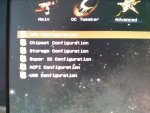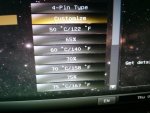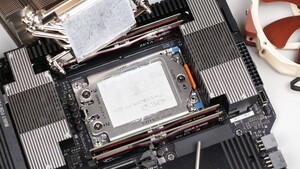J
jumijumi
Gast
Hallo Leute,
ich habe heute mein Paket bekommen.
In diesem war ein Athlon 5350 und ein ASRock AM1H-ITX. Die Kombination hat mich um die 100€ gekostet.
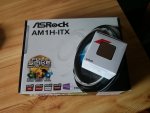
Ich hatte vorher einen FX4100 und eine HD6790, allerdings war mir diese Kombination zu laut, zu groß, wurde zu warm und verbrauchte zu viel Strom. Da sich mein Nutzungsverhalten in letzer Zeit radikal verändert hat (ich spiele so gut wie gar nicht mehr) habe ich nun bei der neuen AM1 Plattform zugeschlagen.
Ich erhoffe mir vorallem einen geringen Energieverbauch, wenig Abwärme, ein kleines System und genug Leistung für Office und Multimedia.
Nun gehts ans auspacken:
Mainboard ASROCK AM1H-ITX:
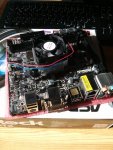
Prozessor Athlon 5350, "diffused in Germany":
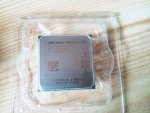
Den Boxed-Kühler kann man auf dem zweiten Bild gut sehen. Ein sehr kleiner Kühler mit einem, ich glaube, 40mm Lüfter welcher die APU gut und leise kühlt. Hohe beträgt ~46mm, ohne Lüfter um die 36mm. Der Lochabstand der Bohrungen im Mainboard beträgt 90mm. Ich habe keine weiteren Lüfter im Gehäuse. Sieht zwar bisschen ulkig aus mit dem kleinem Mainboard, aber ist halt so.
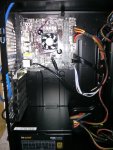 Anhang anzeigen 405400
Anhang anzeigen 405400
Folgende Hardware ist zum Test verbaut:
Athlon 5350
ASRock AM1H-ITX
8GB 1333MHz RAM
64GB SSD SanDisk
430W BeQuiet Netzteil oder 19V ~90W DC Laptopnetzteil
Vorteil des Mainboard ist, dass man entweder einen normalen ATX-Stromanschluss hat (keinen extra Stromanschluss für die APU) oder einen DC-Jack für Laptopnetzteile ( -> passiv und höhere Effiziens).
Habe das System nun soweit aufgesetzt.
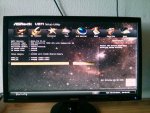
Windows-Leistungsindex:
Anhang anzeigen 405175Anhang anzeigen 405176
Erster Eindruck:
Es gibt im BIOS sehr wenig Einstellmöglichkeiten. Natürlich Boot-Reihenfolge usw. und auch eine erstaunlich gute Lüftersteuerung, allerdings nichts für Spannung oder Multi der APU.
Das System läuft dennoch erstaunlich schnell und flüssig. Wobei das wahrscheinlich eher der SSD zu verdanken ist. Habe bis jetzt auch nur kurz im Web gesurft und mal Office getestet.
1080p Videos laufen super, auch Youtube geht ohne Probleme, aber das war ja zu erwarten.
FullHD Videowiedergabe (Youtube):

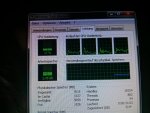
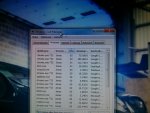
Spiel (Kerbal Space Program) auf Min. aber 1080p ohne AF usw.:
Spielbar mit ~25fps, aber hässlich, nicht empfehlenswert.
Auf 720p und niedriger jedoch gut und bei 800*600 sogar auf Max. spielbar, jedoch realitätsfern.
Maxon CINEBENCH R15:

Maxon CINEBENCH 11.5:
UNiGiNE Heaven Benchmark 4.0:

Ergebniss: 135 Punkte und Avg. 17,2fps bei Max. 25,3fps und Min. 8,9fps
Betrieb mit 19V Netzteil:
Ich betreibe den Rechner nun mit einem 19V Netzteil von ASUS mit 90W (P=U*I und so).
Das Tolle: Kein Lärm. Und es hat genug Leistung. Beim zweiten Bild kann man gut den Mainboardanschluss für die SATA-Stromversorgung (mit 2 SATA-Stormanschlüssen) erkennen.
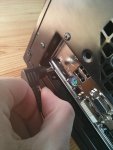
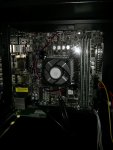
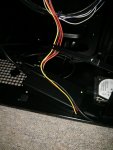
CPU-Z und HWinfo sowie Lüftergeschwindigkeit:
(Genauere Infos im Anhang: zip-Ordner "cpu-z html"; Lüftergeschw. bleibt komischerweise immer gleich, auch bei Volllast -> "Silent Mode" im BIOS eingestellt.)

Anhang anzeigen 405518Anhang anzeigen 405519
Das Es iwie ein Problem mit den Screenshots gibt: 1200rpm.
Temperaturen:
Raumtemperatur: 18°C
In Reihenfolge: Idle || Bisschen Surfen und Musikhören || Volllast CPU und Grafikteil



(Nach 5 Minuten stagniert Temperaturerhöhung.)
Bin mir nicht sicher ob CoreTemp falsche Temperaturen ausliest, der Kühler so gut kühlt bzw. da das Gehäuse so groß ist oder ob es hier 0° sind. Auch sieht es so aus, als ob die APU nicht hochtaktet, das ist allerdings ein Auslesefehler.
Stromverbrauch
Also das System läuft auch unter Volllast problemlos mit einem 60W 19V Netzteil. Deshalb liegt der Verbrauch erwartungsgemäß unter 60W.
Würde auch gerne einen Test zum Stormverbrauch machen, habe nur leider kein Messgerät dafür und wie glaube ich bekannt ist haben die Geschäfte Sonntags nicht auf.
Gruß
jumijumi
ich habe heute mein Paket bekommen.
In diesem war ein Athlon 5350 und ein ASRock AM1H-ITX. Die Kombination hat mich um die 100€ gekostet.

Da jetzt schon sehr viele Test verfügbar sind habe ich mir mal die Mühe gemacht, und versucht sie hier auszulisten:
Tralalákov AMD Athlon 5350 2.05GHz (QuadCore, Jaguar) (Fragt mich nicht welche Sprache das ist.)
http://forum.cnews.cz/viewtopic.php?f=2&t=1774&p=333643#p333629
Jäger des Celeron AMD liefert die AM1-Prozessoren Athlon und Sempron aus
http://www.heise.de/ct/heft/2014-9-...ozessoren-Athlon-und-Sempron-aus-2163351.html
The Desktop Kabini Review Part 1: AMD Athlon 5350 (AM1) Tested
http://www.anandtech.com/show/7933/the-desktop-kabini-review-part-1-athlon-5350-am1/3
AMD Athlon 5350 APU On Linux
http://www.phoronix.com/scan.php?page=article&item=amd_athlon5350_ubuntu&num=1
Der gesockelte Kabini - Athlon 5350 im Test
http://www.planet3dnow.de/cms/9323-kabini-fuer-sockel-am1-athlon-5350-im-test/
Review: AMD Athlon 5350 (28nm Kabini)
http://hexus.net/tech/reviews/cpu/68473-amd-athlon-5350-28nm-kabini/?page=8
DDR3 Memory Scaling Performance With AMD's Athlon 5350
http://hexus.net/tech/reviews/cpu/68473-amd-athlon-5350-28nm-kabini/?page=8
Video-Review:
https://www.youtube.com/watch?v=JGRKmc5T_n0
Tralalákov AMD Athlon 5350 2.05GHz (QuadCore, Jaguar) (Fragt mich nicht welche Sprache das ist.)
http://forum.cnews.cz/viewtopic.php?f=2&t=1774&p=333643#p333629
Jäger des Celeron AMD liefert die AM1-Prozessoren Athlon und Sempron aus
http://www.heise.de/ct/heft/2014-9-...ozessoren-Athlon-und-Sempron-aus-2163351.html
The Desktop Kabini Review Part 1: AMD Athlon 5350 (AM1) Tested
http://www.anandtech.com/show/7933/the-desktop-kabini-review-part-1-athlon-5350-am1/3
AMD Athlon 5350 APU On Linux
http://www.phoronix.com/scan.php?page=article&item=amd_athlon5350_ubuntu&num=1
Der gesockelte Kabini - Athlon 5350 im Test
http://www.planet3dnow.de/cms/9323-kabini-fuer-sockel-am1-athlon-5350-im-test/
Review: AMD Athlon 5350 (28nm Kabini)
http://hexus.net/tech/reviews/cpu/68473-amd-athlon-5350-28nm-kabini/?page=8
DDR3 Memory Scaling Performance With AMD's Athlon 5350
http://hexus.net/tech/reviews/cpu/68473-amd-athlon-5350-28nm-kabini/?page=8
Video-Review:
https://www.youtube.com/watch?v=JGRKmc5T_n0
Ich erhoffe mir vorallem einen geringen Energieverbauch, wenig Abwärme, ein kleines System und genug Leistung für Office und Multimedia.
Nun gehts ans auspacken:
Mainboard ASROCK AM1H-ITX:

Prozessor Athlon 5350, "diffused in Germany":

http://www.cpu-world.com/CPUs/Jaguar/AMD-Athlon 5350 - AD5350JAH44HM.html
AMD Athlon family, based on "Kabini" core, is a family of budget low power processors for socket AM1 platform. First details of these processors emerged in November 2013. The platform was announced by AMD in March 2014, and is expected to launch on April 9.
The Athlon Accelerated Processing Units, or APUs, have all of the features of mobile "Kabini" counterparts, and use somewhat higher CPU and GPU frequencies to deliver better performance at the expense of higher power consumption. The Athlons have 4 CPU cores, 64 KB exclusive L1 cache per each core, and 2 MB level 2 cache, shared between the cores. The processors support all SIMD instructions starting from MMX, and up to AES, AVX, Bit Manipulation and Float 16. The list of supported technologies includes AMD64, as well as AMD Virtualization with nested pages (also called rapid virtualization indexing).
Graphics portion of the chip contains a GPU, a Video Compression Engine (VCE), and a Universal Video Decoder (UVD). The GPU is built on Graphics Core Next architecture, and has 128 shaders. It supports DirectX 11.2, OpenCL 1.2, OpenGL 4.1+, and DirectCompute 11 APIs. The Universal Video Decoder accelerates decoding of VC-1, MPEG, MPEG2, MPEG4, MVC, WMV-9 and H.264 formats. The purpose of the VCE is to encode video stream into H.264 format, and it can be also used for transcoding when it is chained to the UVD output.
It became common for modern CPUs to integrate a memory controller, and the Athlons are not an exception. The memory controller is 64-bit wide, which means it has only a single channel. It works with up to 2 DIMMS of DDR3 1.5V, DDR3L 1.35V or DDR3U 1.2 V memory. The former two support data rates up to 1600 MHz, and the latter supports data rate up to 1333 MHz.
The Athlon APUs are designed as systems on a chip, i.e. not only they integrate the CPU and GPU, but they also have the chipset logic embedded. That logic consists of USB 1.1/2.0/3.0, PCI Express 2.0, SATA 3.0, Secure Digital, and various legacy interfaces. The chips also have VGA, DVI, HDMI, DisplayPort and LVDS display interfaces. The maximum resolution for DisplayPort output is 2560 x 1600 at 60 Hz, or 4096 x 2160 at 30 Hz. HDMI interface supports 1920 x 1200 at 60 Hz, or 4096 x 2160 at 24 Hz resolution. The APUs have two display controllers, which allows them to support dual-display mode.
The Athlon APUs are low-power processors with just 25 Watt TDP, and they use a number of techniques to reduce power consumption. Besides PowerNow technology, that lowers CPU frequency and core voltage when maximum performance is not required, the chips also have several low power states, such as C1 and CC6, that reduce power in idle mode. Another method of reducing power consumption is to completely turn off unneeded units, and "Kabini" core accomplishes this by power gating of GPU, VCE, UVD, PCI-Express and Graphics memory controller units.
The APUs are produced in a micro-PGA package, that fits into socket AM1 (socket FS1b).
AMD Athlon family, based on "Kabini" core, is a family of budget low power processors for socket AM1 platform. First details of these processors emerged in November 2013. The platform was announced by AMD in March 2014, and is expected to launch on April 9.
The Athlon Accelerated Processing Units, or APUs, have all of the features of mobile "Kabini" counterparts, and use somewhat higher CPU and GPU frequencies to deliver better performance at the expense of higher power consumption. The Athlons have 4 CPU cores, 64 KB exclusive L1 cache per each core, and 2 MB level 2 cache, shared between the cores. The processors support all SIMD instructions starting from MMX, and up to AES, AVX, Bit Manipulation and Float 16. The list of supported technologies includes AMD64, as well as AMD Virtualization with nested pages (also called rapid virtualization indexing).
Graphics portion of the chip contains a GPU, a Video Compression Engine (VCE), and a Universal Video Decoder (UVD). The GPU is built on Graphics Core Next architecture, and has 128 shaders. It supports DirectX 11.2, OpenCL 1.2, OpenGL 4.1+, and DirectCompute 11 APIs. The Universal Video Decoder accelerates decoding of VC-1, MPEG, MPEG2, MPEG4, MVC, WMV-9 and H.264 formats. The purpose of the VCE is to encode video stream into H.264 format, and it can be also used for transcoding when it is chained to the UVD output.
It became common for modern CPUs to integrate a memory controller, and the Athlons are not an exception. The memory controller is 64-bit wide, which means it has only a single channel. It works with up to 2 DIMMS of DDR3 1.5V, DDR3L 1.35V or DDR3U 1.2 V memory. The former two support data rates up to 1600 MHz, and the latter supports data rate up to 1333 MHz.
The Athlon APUs are designed as systems on a chip, i.e. not only they integrate the CPU and GPU, but they also have the chipset logic embedded. That logic consists of USB 1.1/2.0/3.0, PCI Express 2.0, SATA 3.0, Secure Digital, and various legacy interfaces. The chips also have VGA, DVI, HDMI, DisplayPort and LVDS display interfaces. The maximum resolution for DisplayPort output is 2560 x 1600 at 60 Hz, or 4096 x 2160 at 30 Hz. HDMI interface supports 1920 x 1200 at 60 Hz, or 4096 x 2160 at 24 Hz resolution. The APUs have two display controllers, which allows them to support dual-display mode.
The Athlon APUs are low-power processors with just 25 Watt TDP, and they use a number of techniques to reduce power consumption. Besides PowerNow technology, that lowers CPU frequency and core voltage when maximum performance is not required, the chips also have several low power states, such as C1 and CC6, that reduce power in idle mode. Another method of reducing power consumption is to completely turn off unneeded units, and "Kabini" core accomplishes this by power gating of GPU, VCE, UVD, PCI-Express and Graphics memory controller units.
The APUs are produced in a micro-PGA package, that fits into socket AM1 (socket FS1b).
Den Boxed-Kühler kann man auf dem zweiten Bild gut sehen. Ein sehr kleiner Kühler mit einem, ich glaube, 40mm Lüfter welcher die APU gut und leise kühlt. Hohe beträgt ~46mm, ohne Lüfter um die 36mm. Der Lochabstand der Bohrungen im Mainboard beträgt 90mm. Ich habe keine weiteren Lüfter im Gehäuse. Sieht zwar bisschen ulkig aus mit dem kleinem Mainboard, aber ist halt so.
 Anhang anzeigen 405400
Anhang anzeigen 405400Folgende Hardware ist zum Test verbaut:
Athlon 5350
ASRock AM1H-ITX
8GB 1333MHz RAM
64GB SSD SanDisk
430W BeQuiet Netzteil oder 19V ~90W DC Laptopnetzteil
Vorteil des Mainboard ist, dass man entweder einen normalen ATX-Stromanschluss hat (keinen extra Stromanschluss für die APU) oder einen DC-Jack für Laptopnetzteile ( -> passiv und höhere Effiziens).
Habe das System nun soweit aufgesetzt.

Windows-Leistungsindex:
Anhang anzeigen 405175Anhang anzeigen 405176
Erster Eindruck:
Es gibt im BIOS sehr wenig Einstellmöglichkeiten. Natürlich Boot-Reihenfolge usw. und auch eine erstaunlich gute Lüftersteuerung, allerdings nichts für Spannung oder Multi der APU.
Das System läuft dennoch erstaunlich schnell und flüssig. Wobei das wahrscheinlich eher der SSD zu verdanken ist. Habe bis jetzt auch nur kurz im Web gesurft und mal Office getestet.
1080p Videos laufen super, auch Youtube geht ohne Probleme, aber das war ja zu erwarten.
FullHD Videowiedergabe (Youtube):



Spiel (Kerbal Space Program) auf Min. aber 1080p ohne AF usw.:
Spielbar mit ~25fps, aber hässlich, nicht empfehlenswert.
Auf 720p und niedriger jedoch gut und bei 800*600 sogar auf Max. spielbar, jedoch realitätsfern.
Maxon CINEBENCH R15:

Maxon CINEBENCH 11.5:
UNiGiNE Heaven Benchmark 4.0:

Ergebniss: 135 Punkte und Avg. 17,2fps bei Max. 25,3fps und Min. 8,9fps
Betrieb mit 19V Netzteil:
Ich betreibe den Rechner nun mit einem 19V Netzteil von ASUS mit 90W (P=U*I und so).
Das Tolle: Kein Lärm. Und es hat genug Leistung. Beim zweiten Bild kann man gut den Mainboardanschluss für die SATA-Stromversorgung (mit 2 SATA-Stormanschlüssen) erkennen.



CPU-Z und HWinfo sowie Lüftergeschwindigkeit:
(Genauere Infos im Anhang: zip-Ordner "cpu-z html"; Lüftergeschw. bleibt komischerweise immer gleich, auch bei Volllast -> "Silent Mode" im BIOS eingestellt.)

Das Es iwie ein Problem mit den Screenshots gibt: 1200rpm.
Temperaturen:
Raumtemperatur: 18°C
In Reihenfolge: Idle || Bisschen Surfen und Musikhören || Volllast CPU und Grafikteil



(Nach 5 Minuten stagniert Temperaturerhöhung.)
Bin mir nicht sicher ob CoreTemp falsche Temperaturen ausliest, der Kühler so gut kühlt bzw. da das Gehäuse so groß ist oder ob es hier 0° sind. Auch sieht es so aus, als ob die APU nicht hochtaktet, das ist allerdings ein Auslesefehler.
Stromverbrauch
Also das System läuft auch unter Volllast problemlos mit einem 60W 19V Netzteil. Deshalb liegt der Verbrauch erwartungsgemäß unter 60W.
Würde auch gerne einen Test zum Stormverbrauch machen, habe nur leider kein Messgerät dafür und wie glaube ich bekannt ist haben die Geschäfte Sonntags nicht auf.
Gruß
jumijumi
Anhänge
Zuletzt bearbeitet:


